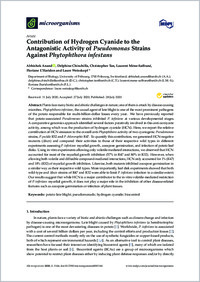Contribution of hydrogen cyanide to the antagonistic activity of Pseudomonas strains against Phytophthora infestans
- Anand, Abhishek Department of Biology, University of Fribourg, 1700 Fribourg, Switzerland
- Chinchilla, Delphine Department of Biology, University of Fribourg, 1700 Fribourg, Switzerland
- Tan, Christopher Department of Biology, University of Fribourg, 1700 Fribourg, Switzerland
- Mène-Saffrané, Laurent Department of Biology, University of Fribourg, 1700 Fribourg, Switzerland
- L'Haridon, Floriane Department of Biology, University of Fribourg, 1700 Fribourg, Switzerland
- Weisskopf, Laure Department of Biology, University of Fribourg, 1700 Fribourg, Switzerland
-
20.07.2020
Published in:
- Microorganisms. - 2020, vol. 8, no. 8, p. 1144
English
Plants face many biotic and abiotic challenges in nature; one of them is attack by disease-causing microbes. Phytophthora infestans, the causal agent of late blight is one of the most prominent pathogens of the potato responsible for multi-billion-dollar losses every year. We have previously reported that potato-associated Pseudomonas strains inhibited P. infestans at various developmental stages. A comparative genomics approach identified several factors putatively involved in this anti-oomycete activity, among which was the production of hydrogen cyanide (HCN). Here, we report the relative contribution of HCN emission to the overall anti-Phytophthora activity of two cyanogenic Pseudomonas strains, P. putida R32 and P. chlororaphis R47. To quantify this contribution, we generated HCN-negative mutants (Δhcn) and compared their activities to those of their respective wild types in different experiments assessing P. infestans mycelial growth, zoospore germination, and infection of potato leaf disks. Using in vitro experiments allowing only volatile-mediated interactions, we observed that HCN accounted for most of the mycelial growth inhibition (57% in R47 and 80% in R32). However, when allowing both volatile and diffusible compound-mediated interactions, HCN only accounted for 1% (R47) and 18% (R32) of mycelial growth inhibition. Likewise, both mutants inhibited zoospore germination in a similar way as their respective wild types. More importantly, leaf disk experiments showed that both wild-type and Δhcn strains of R47 and R32 were able to limit P. infestans infection to a similar extent. Our results suggest that while HCN is a major contributor to the in vitro volatile-mediated restriction of P. infestans mycelial growth, it does not play a major role in the inhibition of other disease-related features such as zoospore germination or infection of plant tissues.
- Faculty
- Faculté des sciences et de médecine
- Department
- Département de Biologie
- Language
-
- English
- Classification
- Biological sciences
- License
-
License undefined
- Identifiers
-
- RERO DOC 329401
- DOI 10.3390/microorganisms8081144
- Persistent URL
- https://folia.unifr.ch/unifr/documents/308877
Other files
Statistics
Document views: 119
File downloads:
- pdf: 289
- Supplementary material: 173

